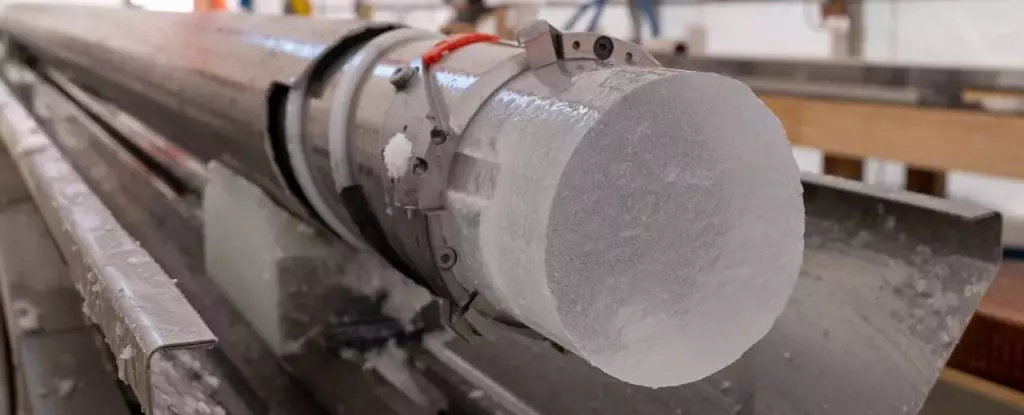Recent explorations in Antarctica have unearthed an ice core that may hold the oldest and most complete record of the Earth’s climate history, dating back over a million years. This monumental discovery, achieved through the efforts of the European Project for Ice Coring in Antarctica (EPICA), could redefine our understanding of historical climate change and provide critical insights into contemporary environmental challenges. The core, stretching an impressive 2,800 meters (approximately 9,186 feet), represents a trove of geological information—one that could rival the length of San Francisco’s iconic Golden Gate Bridge when laid out horizontally.
With every meter of this ice core encapsulating up to 13,000 years of compressed history, it serves not just as a record of time but as a window into past atmospheres, preserved within tiny bubbles of ancient air. Such samples allow for the reconstruction of Earth’s climatic conditions at various intervals, significantly contributing to our comprehension of natural climatic cycles and the anthropogenic influences that are threatening to disrupt them.
According to Julien Westhoff, the lead scientist overseeing this ambitious drilling project, preliminary findings suggest that the upper section of this ice core contains climate data extending back as far as 1.2 million years. More importantly, researchers are hopeful that the deepest segments may date back to a much earlier period, potentially ranging from 2.5 million years, which would provide a comprehensive timeline of Earth’s climatic transitions. While the oldest ice ever extracted in Antarctica was determined to be around 2.7 million years, it was not collected in a manner that yielded a continuous record, rendering it more of a brief historical snapshot rather than a detailed chronicle.
Historically, the EPICA project successfully collected vertical ice core samples that covered the last 740,000 years, but this new drilling initiative opens the door to understanding periods of extreme climate variability that have not been fully explored. Specifically, the timeframe under scrutiny—between 900,000 and 1.2 million years ago—coincides with an era of extended glacial periods. Alarmingly, evidence suggests that significant swathes of early human populations in Africa may have perished during this harsh climate, a theory supported by genetic studies, though still debated among experts.
The unveiling of this ancient ice core brings with it a responsibility and opportunity to comprehend how past climate events have shaped our environment and may continue to shape human existence. Carlo Barbante, the director of the EPICA project, emphasizes that understanding the interplay between greenhouse gas concentrations and temperature fluctuations over eons is crucial. The data obtained from this investigation may shed light on the profound relationships influencing both climate patterns and ice sheet dynamics, thus enhancing our knowledge of climate shifts that occurred long before industrialization.
Current debates around climate change often invoke the notion of feedback loops resulting from human activity. The information extracted from the new ice core has the potential not only to validate but also to contextualize the deviations caused by anthropogenic emissions, positioning them within a historical framework. This context is vital for scientists, policymakers, and the general public in grasping the urgency and scale of the current climate crisis.
The location chosen for drilling, known as Little Dome C in East Antarctica, was strategically selected based on radar surveys that indicated the presence of robust and well-layered ice—akin to layers in a cake—ideal for extracting a long-term climate record. At an elevation of 3,200 meters, Little Dome C presents its own challenges, as researchers contend with continuously frigid summer temperatures hovering around -35 °C (-31 °F) coupled with strong winds.
The logistical challenges were immense; it took researchers around 20 days to transport the necessary equipment and supplies to the remote drilling site. Ultimately, the effort paid off as each segment of the ice core was immediately subjected to isotopic analysis upon extraction, enabling scientists to analyze glacial and interglacial cycles in near real-time.
As we move forward, the rich data anticipated from this drilling endeavor promises to unravel not only the Earth’s climate history but also the lessons it imparts about our present and future. Climate experts like Richard Alley assert it is a chance to potentially unearth extraordinary revelations about our planet’s past, reinforcing the significance of such scientific endeavors in addressing the challenges of climate change.
The insights derived from this remarkable ice core discovery will be instrumental as we strive to navigate the complexities of climate change. Understanding the workings of Earth’s climate system and how it has been influenced over millions of years contributes immensely to resolving the modern-day crisis. Therefore, as we look to the past through this ancient ice, we also gaze forward—armed with knowledge and a deeper appreciation of our fragile yet resilient planet. Each layer of ice not only marks the passage of time; it serves as a poignant reminder of the interconnectedness of climate, survival, and the time-worn legacy we are bound to respect and protect.


Leave a Reply